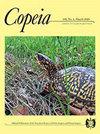Two New Species of Pencil Wrasses (Teleostei: Labridae: Pseudojuloides) from Micronesia and the Marquesan Islands
IF 2.6
Q2 Agricultural and Biological Sciences
引用次数: 1
Abstract
Pseudojuloides pluto, new species, is described on the basis of the holotype and 11 paratypes from Wake Island, northeastern Micronesia, and nine paratypes from the Maug Islands, Northern Mariana Islands. The new species has previously been confused with Pseudojuloides atavai, but molecular analysis of mitochondrial COI reveals a difference of 6.8% in sequence data between both species, in addition to differences in meristic, morphometric, and coloration details. A second new species, Pseudojuloides proserpina, is described from Fatu Hiva, Marquesan Islands on the basis of the male holotype. The two new species are closely allied to Pseudojuloides atavai, and together form a species complex that differs from other members of the genus in having males that share the following combination of characters: interspinous membrane between the anterior two to three spines of the dorsal fin with a black spot; head extensively reticulate (reduced in P. pluto, new species); dorsal-fin base with a pink stripe; abdominal region behind pectoral and pelvic fins pale lilac to orangey pink (width of this region dependent on species) with a crosshatch or honeycomb pattern; and extensive black coloration over at least posterior half of body. Additionally, females of both P. atavai and P. pluto, new species, are distinctly bicolored (versus unicolored and suffused in all other congeneric species). Although the female form of P. proserpina, new species, is not known, it is likely that it shares this general coloration pattern, which may serve as an additional character uniting members of the Pseudojuloides atavai complex. We briefly discuss the phylogenetic relationships of Pseudojuloides inferred on the basis of mitochondrial DNA.密克罗尼西亚和马尔克斯桑群岛的两个新Pencil Wrasses属(Teleosteri:Labridae:Pseudojuloides)
根据密克罗尼西亚东北部威克岛的正模和11个副模,以及北马里亚纳群岛毛格群岛的9个副模描述了pluto假juloides新种。这一新物种此前曾被混淆为Pseudojuloides atavai,但线粒体COI的分子分析显示,除了分生组织、形态计量和着色细节的差异外,两个物种之间的序列数据差异为6.8%。在雄性正模的基础上,描述了马尔克斯桑群岛法图海瓦的第二个新物种,Pseudojuloides proserpina。这两个新物种与Pseudojuloides atavai密切相关,共同形成了一个物种复合体,与该属其他成员的不同之处在于,雄性具有以下特征组合:背鳍前两到三棘之间的棘间膜,带有一个黑点;头部广泛网状(在P.pluto中减少,新种);背鳍基部具粉红色条纹;胸鳍和骨盆鳍后面的腹部区域为淡紫色至橙粉色(该区域的宽度取决于物种),具有交叉线或蜂窝状图案;以及至少身体后半部分的广泛黑色。此外,P.atavai和P.pluto这两个新物种的雌性都明显是双色的(而所有其他同类物种都是单色的)。尽管新物种P.proserpina的雌性形态尚不清楚,但它很可能具有这种普遍的着色模式,这可能是将Pseudojuloides atavai复合体成员结合在一起的一个额外特征。我们简要地讨论了基于线粒体DNA推断的假多倍体的系统发育关系。
本文章由计算机程序翻译,如有差异,请以英文原文为准。
求助全文
约1分钟内获得全文
求助全文
来源期刊

Copeia
生物-动物学
CiteScore
2.10
自引率
0.00%
发文量
0
审稿时长
6-12 weeks
期刊介绍:
Founded in 1913, Copeia is a highly respected international journal dedicated to the publication of high quality, original research papers on the behavior, conservation, ecology, genetics, morphology, evolution, physiology, systematics and taxonomy of extant and extinct fishes, amphibians, and reptiles. Copeia is published electronically and is available through BioOne. Articles are published online first, and print issues appear four times per year. In addition to research articles, Copeia publishes invited review papers, book reviews, and compiles virtual issues on topics of interest drawn from papers previously published in the journal.
 求助内容:
求助内容: 应助结果提醒方式:
应助结果提醒方式:


